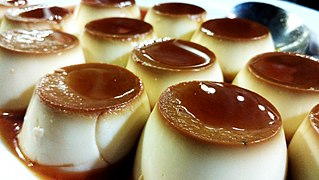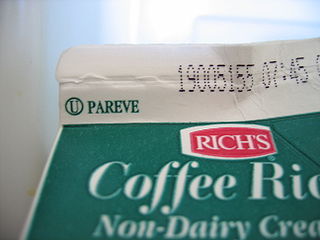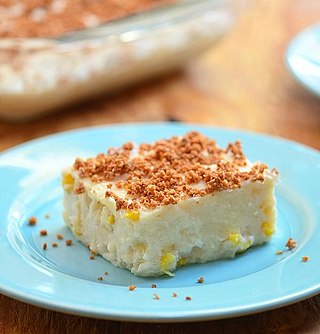Related Research Articles

Brazilian cuisine is the set of cooking practices and traditions of Brazil, and is characterized by European, Amerindian, African, and Asian influences. It varies greatly by region, reflecting the country's mix of native and immigrant populations, and its continental size as well. This has created a national cuisine marked by the preservation of regional differences.

Brie is a soft cow's-milk cheese named after Brie, the French region from which it originated. It is pale in color with a slight grayish tinge under a rind of white mould. The rind is typically eaten, with its flavor depending largely upon the ingredients used and its manufacturing environment. It is similar to Camembert, which is native to a different region of France. Brie typically contains between 60% and 75% butterfat, slightly higher than Camembert.

Crème caramel, flan, caramel pudding, condensed milk pudding or caramel custard is a custard dessert with a layer of clear caramel sauce.

Camembert is a moist, soft, creamy, surface-ripened cow's milk cheese. It was first made in the late 18th century in Camembert, Normandy, in northwest France. It is sometimes compared in look and taste to brie cheese, albeit with a slightly lower butterfat content than brie's typical 20% – 25% by weight.

Cheesecake is a dessert made with a soft fresh cheese, eggs, and sugar. It may have a crust or base made from crushed cookies, graham crackers, pastry, or sometimes sponge cake. Cheesecake may be baked or unbaked, and is usually refrigerated.

Risotto is an Italian rice dish cooked with broth until it reaches a creamy consistency. The broth can be derived from meat, fish, or vegetables. Many types of risotto contain butter, onion, white wine, and Parmesan cheese. It is one of the most common ways of cooking rice in Italy. Saffron was originally used for flavour and its signature yellow colour.

Wine and food matching is the process of pairing food dishes with wine to enhance the dining experience. In many cultures, wine has had a long history of being a staple at the dinner table and in some ways both the winemaking and culinary traditions of a region will have evolved together over the years. Rather than following a set of rules, local cuisines were paired simply with local wines. The modern "art" of food pairings is a relatively recent phenomenon, fostering an industry of books and media with guidelines for pairings of particular foods and wine. In the restaurant industry, sommeliers are often present to make food pairing recommendations for the guest. The main concept behind pairings is that certain elements in both food and wine interact with each other, and thus finding the right combination of these elements will make the entire dining experience more enjoyable. However, taste and enjoyment are very subjective and what may be a "textbook perfect" pairing for one taster could be less enjoyable to another.

Jewish cuisine refers to the worldwide cooking traditions of the Jewish people. During its evolution over the course of many centuries, it has been shaped by Jewish dietary laws (kashrut), Jewish festivals and holidays, and traditions centred around Shabbat. Jewish cuisine is influenced by the economics, agriculture, and culinary traditions of the many countries where Jewish communities have settled and varies widely throughout the entire world.

In kashrut, the dietary laws of Judaism, pareve is a classification of edible substances that contain neither dairy nor meat ingredients. Food in this category includes all items that grow from the ground, fish, eggs, and non-biological edible items.

Fontina is a cow's milk cheese, first produced in Italy. Over time, production of Fontina has spread worldwide, including to the United States, Denmark, Sweden, Canada, France and Argentina.

Israeli cuisine primarily comprises dishes brought from the Jewish diaspora, and has more recently been defined by the development of a notable fusion cuisine characterized by the mixing of Jewish cuisine and Arab cuisine. It also blends together the culinary traditions of the various diaspora groups, namely those of Middle Eastern Jews with roots in Southwest Asia and North Africa, Sephardi Jews from Iberia, and Ashkenazi Jews from Central and Eastern Europe.

Cheese soup is a type of soup prepared using cheese as a primary ingredient, along with milk, broth and/or stock to form its basis. Various additional ingredients are used in its preparation, and various types and styles of cheese soup exist. It is a part of some cuisines in the world, such as American, Colombian, Mexican, Swiss, French, and Tibetan cuisines. Mass-produced cheese soups may be prepared with the addition of food additives to preserve them and enhance flavor. A list of cheese soups is included in this article.

Maja blanca is a Filipino dessert with a gelatin-like consistency made primarily from coconut milk. Also known as coconut pudding, it is usually served during fiestas and during the holidays, especially Christmas.
Gvina levana, which means "white cheese" in Hebrew, also known as Israeli white cheese, is a soft, creamy, and tangy cheese that is popular in Israel. The cheese is made from cow's milk and has a crumbly texture and a slightly sour taste. It is used in a variety of dishes in Israeli cuisine and is an important part of Israeli culture.
Crema is the Spanish word for cream. In the United States, or in the English language, it is sometimes referred to as crema espesa, also referred to as crema fresca in Mexico. Crema fresca or crema espesa is a Mexican dairy product prepared with two ingredients, heavy cream and buttermilk. Salt and lime juice may also be used in its preparation. Crema's fat content can range between 18 and 36 percent. In Mexico, it is sold directly to consumers through ranches outside large cities, as well as being available in Mexican and Latin American grocery stores in the United States. Crema is used as a food topping, a condiment and as an ingredient in sauces. It is similar in texture and flavor to France's crème fraîche and sour cream.
Galil cheese, also known as Israeli yellow cheese is a type of cheese that is made in Israel. It is a semi-hard, yellow cheese that is similar in taste and texture to cheddar cheese.
Israeli feta cheese or, also known as Israeli-style feta cheese or simply Israeli cheese, is a type of white cheese made from sheep's milk, cow's milk, or a combination of both. It is an appropriated Greek feta cheese, but has a milder flavor and a creamier texture.
References
- 1 2 3 4 5 6 7 Rogov, Daniel (2005). The Ultimate Guide to Israeli Wines. Gefen Publishing House.
- 1 2 3 4 5 6 7 Solomonov and Cook, Mike and Steven (2018). Israeli Soul: Easy, Essential, Delicious. HMH.
- 1 2 3 4 5 6 7 Atlas, Gil (2012). The New Middle Eastern Vegetarian: Modern Recipes from Veggiestan. Bloomsbury Publishing.
- 1 2 3 4 5 6 7 Schreiber, Anne (2010). The Ultimate Guide to Kosher Cheese. Universe Publishing.
- 1 2 3 4 5 6 7 Lewin, Susan (2002). The Ultimate Recipe Collection: Kosher Cuisine. Love & Cooking.
- 1 2 3 4 5 6 7 "Foodies Unite: Best Cheese to Try in Israel". Ha'aretz. Ha'aretz. Retrieved 29 March 2023.
- 1 2 3 4 5 6 7 "Artisan Cheese in Israel". Ministry of Agriculture and Rural Development. Retrieved 29 March 2023.